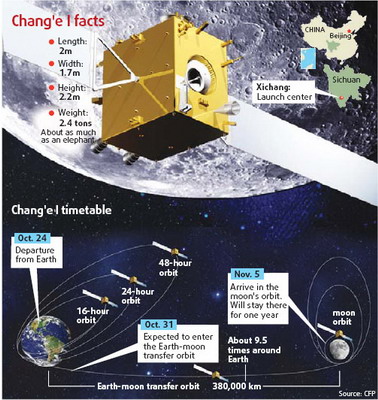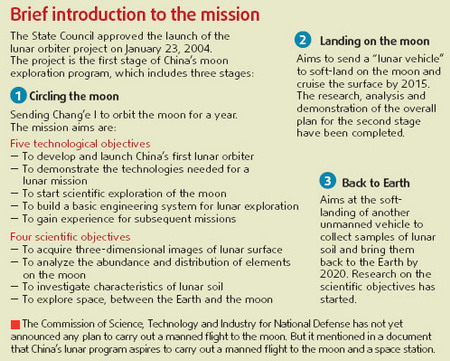Source: China Daily
10-25-2007 11:03
Special Report: Chang'e I -Journey to the Moon |
The country's lunar probe blasted off towards the Earth's only satellite yesterday evening on a 380,000 km journey that is a decisive step in the nation's quest to explore "deep space".
The one-year voyage, Asia's second after Japan's Selene probe took off on September 14, was nearly half a century apart from the world's first lunar flyby by a Soviet Union orbiter.
But Chang'e I the orbiter is set to conduct research not yet done by orbiters from other countries, Chinese scientists said.
 |
Over the past 30 years, China has achieved space feats a developing country could have only dreamed of: sending satellites of different sizes and shapes into orbit, and carrying out manned missions.
The ringing successes may help elevate China as a space-faring country, but it still has challenges to overcome to fulfil its ambitions and aspirations of pursuing technological innovations and testing its scientific limits.
"Launching man-made satellites, manned space flights and conducting deep-space exploration constitute a trilogy of space activities," Ouyang Ziyuan, chief scientist of China's lunar exploration program, said.
Sun Laiyan, director of the China National Space Administration, had said earlier that the moon could be used as a "relay station" from which scientists can travel further to the frontier.
In other words, the moon provides a good platform to launch a probe into outer space.
China officially approved its lunar probe program in 2004, with its first step being the launch of a satellite to orbit the moon.
An unmanned moon landing and the launch of a moon rover around 2012 will follow.
Ye Peijian, chief designer and commander-in-chief of the satellite system of the country's lunar probe program, said the Chinese program started relatively late, but it has a high starting point.
"Our first step is to circle the moon, not a flyby," he said. "Besides, we have clear-cut scientific objectives, some of which have never been done successfully, or not attempted at all," Xinhua quoted him as saying on the eve of yesterday's launch.
Chang'e I uses stereo cameras and X-ray spectrometers to map three-dimensional images of the moon's surface.
"Three-dimensional imaging of the whole moon in a real sense has not been done before," Ouyang Ziyuan said in his book Introduction to Lunar Science.
Chang'e I will also be the first to use its microwave sounders to gauge the thickness of lunar regolith (soil).
In addition, the orbiter will analyze abundance and distribution of elements, nine of which are yet to be identified, on the lunar surface, said Sun Jiadong, who is the chief designer of China's lunar exploration project.
With these new features, Chinese scientists said they believed the exploration's results would provide new materials for lunar studies and investigation of the moon's resources.
Following are some figures of the lunar orbiter:
-- 1.4 billion yuan: China's milestone lunar orbiter project has cost 1 to 1.4 billion yuan (about 133 to 187 million U.S. dollars) since research and development of the project was approved in the beginning of 2004.
-- 10,000 personnel: There are about 10,000 people involved in the project, including 5,000 researchers involved in five major systems of the project.
-- 103 times: This is the 103th flight of the Long March rocket series.
-- 330 hours: The duration from the rocket blast-off to the satellite establishing its own moon orbit lasts about 330 hours.
-- eight facilities: Chang'e-1 will carry eight probing facilities including a stereo camera and interferometer, an imager and gamma/x-ray spectrometer, a laser altimeter, a microwave detector, a high energy solar particle detector and a low energy ion detector.
-- four objectives: The satellite will fulfil four "scientific objectives", including a three-dimensional survey of the Moon's surface, analysis of the abundance and distribution of elements on lunar surface, an investigation of the characteristics of lunar regolith and the powdery soil layer on the surface, and an exploration of the circumstance between the Earth and the Moon.
-- 2,000 instructions: The Beijing Aerospace Control Center (BACC) will issue about 2,000 instructions during the Chang'e-1 flight to the moon.
Editor:Du Xiaodan
